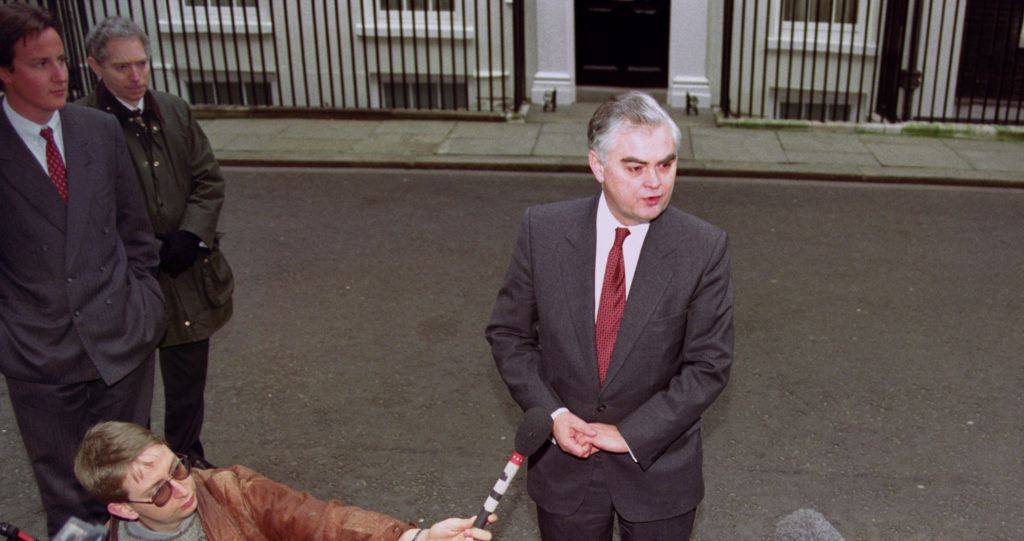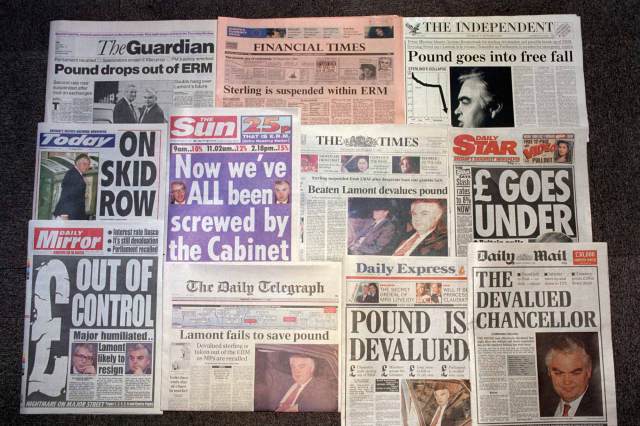Newspaper front pages reporting on the sterling crisis – HARRIS/PA Archive/PA Images

I am not generally a fan of ‘anniversary journalism’ but I do think it is worth marking the twenty-fifth anniversary of ‘Black Wednesday’ – the day that sterling fell out of the EU’s ill-fated Exchange Rate Mechanism (ERM).
Wednesday 16th September 1992 was one of the most tumultuous days in the UK’s peacetime history. A quarter of a century on, the political and financial impact of ‘Black Wednesday’ continues to resonate.
“Today has been an extremely difficult and turbulent day,” said Chancellor Norman Lamont, on the doorstep of HM Treasury, as a mass of television camera top-lights glared upon him. “Massive speculative flows have continued to disrupt the exchange rate mechanism”.
Lamont wasn’t wrong. Britain lost practically all its foreign exchange reserves on Black Wednesday. The Bank of England failed in its bid to counter speculative pressure, as traders forced the pound down and outside specified ERM limits against the German D-Mark.
During the five previous days there had already been financial turmoil, as the markets put the pressure on sterling. Given that the UK was in recession that seemed logical. The Government tried to scare the markets off with massive currency interventions, buying up huge amounts of sterling. But as all traders know, backing a currency depreciation that looks inevitable is a one-way bet, with huge profits to be made if it comes true but tiny losses if not.
At 11am on 16 September, as sterling was being mercilessly dumped, the Bank of England raised interest rates from 10% to 12% – levels unthinkable to many today – in a bid to support the pound. The market did not blink and the rout continued. So a rise to 15% was announced – potentially ruinous for millions of corporate lenders and mortgage-holders. But still, sterling continued to dive.

Just a few hours later, the Bank of England’s coffers were bare and the government bowed to the inevitable. Sterling was freed from its ERM straitjacket and the 15% interest rate was cancelled. Black Wednesday was a moment when political hubris came face to face with economic and financial reality and lost – as eventually it always will.
In terms of domestic politics, Black Wednesday cast a huge cloud over John Major’s government, which had been elected unexpectedly just four months earlier. That was the day the Conservative Party lost its hard-won reputation for economic competence. While interest rates had been in double-digits for several years before, the sense of shock and vulnerability brought by this chaotic exit from the ERM badly undermined the party’s key selling point, paving the way for a Labour renaissance under John Smith and then Tony Blair. Since Black Wednesday, in fact, the Conservatives have struggled to win a general election with a convincing majority.
The second big change, that still resonates, was in the UK’s relationship with the EU. The ERM had existed, in various forms, since 1979 – as a forerunner to the eventual goal of monetary union. The question of UK membership had been a proxy for other ideological differences, not least within the Conservative Party, principally over European integration. Margaret Thatcher opposed ERM membership, the official position being that the UK would join “when the time is right”.
Sterling eventually entered in October 1990, with John Major as Chancellor, a weakening Thatcher eventually giving way to enormous pressure from ‘pro-European’ Tory ministers. Her acquiescence left her fatally wounded, seeing her dethroned by her own party soon after. Major would come to rue the day the UK joined the ERM, of course, given the direct link between Black Wednesday and the pummelling his government received in the general election five years later.
The lingering sense of anger that followed Black Wednesday meant those calling for UK membership of the single currency always had a mountain of public scepticism to climb. As such, having refused to sign the Treaty of Rome in 1957, and eschewing the Euro, Britain would never become a ‘core’ EU member.
Perhaps, the root cause of the June 2016 Brexit referendum can also be found in the currency market turmoil of 25 years ago, “For Britain, the ERM crisis constituted a critical inflection point, that can be regarded as the ‘first Brexit'”, says the veteran financial journalist William Keegan, who with co-authors has written the forthcoming book Six Days in September, a detailed retrospective study of Black Wednesday, including much newly-released archive material.
The UK’s ejection from the ERM was also a profound moment for the EU itself – a landmark in its transition following German reunification in 1990. While the mighty Bundesbank appeared to be the victor of the skirmish, the irony was that the UK’s exchange rate angst, together with the volatility endured by the French Franc the following year, served to give fresh impetus to the Francophone push for monetary union.
There is no doubt that the tumultuous nature of Black Wednesday helped to convince German sceptics that monetary union was necessary, sooner rather than later. As a result, Germany’s central bank lost most of its power. The Bank of England, equally perversely, was a beneficiary – with the ERM debacle ushering in a new period of UK monetary policy, which saw Britain’s central bank gain ‘operational independence’, becoming more powerful as a result.

“The government has concluded that Britain’s best interests are served by suspending our membership of the exchange rate mechanism,” said Norman Lamont on that ill-fated Wednesday night, as a young bag-carrier called David Cameron stood just behind him.
Lamont was right about that too. Outside the ERM, the Pound depreciated, helping pull the UK out of recession and unleashing a period of sustained above-average growth that extended into the 21st century – all the way, in fact, until the credit crunch in 2008. That’s another historic irony – that in the eyes of many, ‘Black Wednesday’ turned out to be ‘White Wednesday’ instead.
***
‘Six Days in September’, by William Keegan, David Marsh and Richard Roberts, is published by OMFIF on 15thSeptember.










Join the discussion
Join like minded readers that support our journalism by becoming a paid subscriber
To join the discussion in the comments, become a paid subscriber.
Join like minded readers that support our journalism, read unlimited articles and enjoy other subscriber-only benefits.
Subscribe